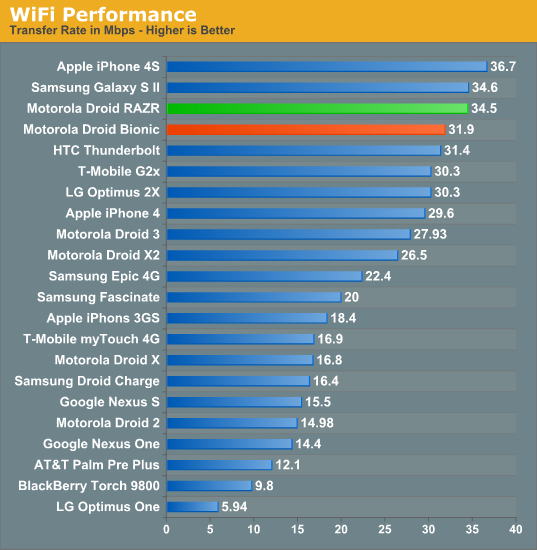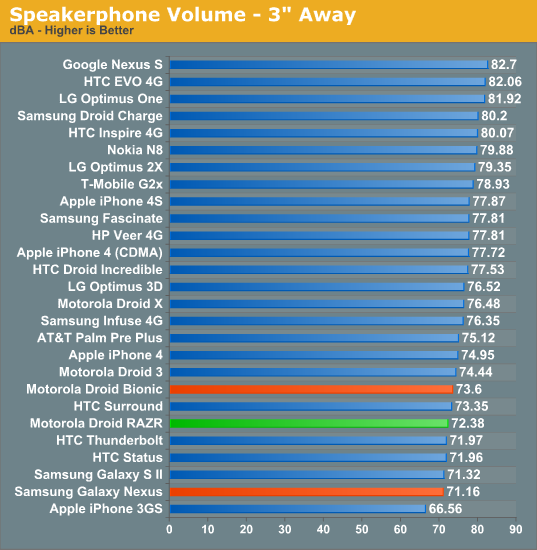Motorola Droid RAZR Review - A Better Clad Bionic
by Brian Klug on December 16, 2011 2:01 AM EST- Posted in
- Smartphones
- Droid
- LTE
- 4G
- Motorola
- Android
- Mobile
- Droid RAZR
- motorola droid RAZR
WiFi, GPS, Audio and Speakerphone
The RAZR uses a TI Wilink 7 series WL1285 combo chip for Bluetooth and WiFi, which is the same situation as the Bionic, unsurprisingly. WiFi is limited to 2.4 GHz and single spatial stream 802.11n, and I saw the RAZR negotiate a 65 Mbps (long guard interval) physical rate with my 20 MHz 802.11n wireless network. I found that range on the RAZR is totally on par with other smartphones I’ve used. Though the visualization at the top seems to be rather conservative with showing bars, if you go view the actual RSSI for WiFi (inside ##4636## and Wireless Information) you’ll see things are just fine. Bluetooth is 4.0 LE + EDR which is the latest bleeding edge.

Throughput on WiFi is pretty decent and just a tad faster than the Bionic. It’s possible the subtle software differences between the two account for this difference in throughput.
WiFi Hotspot
I had some issues with the RAZR’s WiFi hotspot that I didn’t encounter with the Bionic. Specifically, when using the hotspot with WPA2 enabled, clients would only be able to attach occasionally for a short period, or not at all. This initially posed lots of frustration when trying to do our WiFi hotspot battery life test, however disabling encryption entirely and running a public AP resulted in no instability.
You still can attach a maximum of 5 clients if you pay the extra fare to Verizon to enable tethering (which the device does check to see is provisioned), and on the whole this works well, just only with security set to open in my experience.
GPS
To the best of my knowledge, the RAZR is using the GPS system onboard MDM6600 and not from the TI Wilink 7 series combo chip. It’s a bit hard to nail down for sure, but I was able to confirm on the Bionic and it seems reasonable that the same applies here.
Like we’re used to seeing from that system, GPS locks are super fast even indoors and don’t pause or stutter at all. I didn’t have any issues with GPS and used the RAZR a few times with Google navigation without any hitch.
Audio + Speakerphone
First up in the audio department is speakerphone loudness, which we’ve been measuring for a while now using a USB sound level data logger while placing a test call to the local ASOS. The RAZR is on the quiet side which isn’t incredibly surprising considering the placement and constraints on the size of its acoustic chamber.

The other part of audio is of course call quality, and the RAZR isn’t different at all subjectively from the other Motorola phones on Verizon I’ve reviewed recently. As a reminder all calls go over 1x voice, and by default almost every device uses the EVRC coder, though you can change this to 13k in the programming menu and perceive a slight change in call quality. Noise cancellation features likewise remain the same, again courtesy of the three microphones onboard the RAZR.
The last important audio quality metric is what the device sounds like when playing back music. The Bionic used an ST-E 3.1 CPAC combo power management IC and audio codec, and the RAZR uses an ST-E 3.2 CPCAP. I’m embarrassed to admit it, but I only recently discovered how to change (read: disable) the DSP that Motorola has enabled on the RAZR by default (and ostensibly many other of their devices that have crossed my desk). Because I use Google Music, I rarely venture into the first party Music application, and it’s inside here that the settings lurk for DSP, which are by default enabled.
The background whine that I complained about on the Bionic is reduced but still faintly perceptible with sensitive IEMs on the RAZR. Though it is still present, it’s no longer as fatiguing and irritating as it was on the Bionic. I’m not sure whether that’s more a function of ST-E’s 3.2 (as opposed to 3.1) or something else, but it’s much better.
If you’re interested, I also ran a run of RMAA using an ASUS Xonar Xense sound card and line-in on the RAZR, Nexus S with VoodooSound, and a GSM Galaxy Nexus for comparison. The RAZR with all of the equalizer and DSP settings turned off actually isn’t bad at all, and though I’m not an expert at reading RMAA’s tea leaves, it has good noise figures and frequency response, and though noise takes off at the lower frequencies as our own Chris H. pointed out this less than ideal behavior is only 7% of the spectrum.










76 Comments
View All Comments
ananduser - Friday, December 16, 2011 - link
Much better than the one on The Verge.GrizzledYoungMan - Friday, December 16, 2011 - link
As usual, the reviews of wireless devices here kick ass. I'm not really interested in this phone - the wide bezel around the screen and the motoblur really bugged me - but it is a treat to read something about it that amounts to more than "how is this not like an iphone?"Looking forward to the Galaxy Nexus review, even though I'll likely already own it by the time your review is published. On principle, I can't bring myself to buy any phone loaded down with skins and bloatware, so there's only really one Android phone choice for me.
Maybe I'm just surly this morning, but Motorola's latest industrial design language really isn't doing it for me. It has this Tron Legacy-esque cheesy vibe to it that is going to age quickly and poorly, I think. By comparison, it seems like Samsung and Nokia are on the right track, focusing on designs that are respectively helpful and pragmatic, and personal and pleasurable to use.
Apple has been disappointing lately on design. The iPhone 4S body still looks great, but their software is getting more decorated and literal with every revision. I like a lot of things about the 4S - especially the camera - but the software was a huge disappointment.
zeagus - Friday, December 16, 2011 - link
Keep in mind the Galaxy Nexus is suffering some controversy vs. the "Pure Google" GSM version by having had VZW remove Google Wallet from it and adding My Verizon Mobile and Backup Assistant..medi01 - Friday, December 16, 2011 - link
Why do mentioned manufacturers: Appl,Motorol,Noki need battery "tradeoffs" due to slimness and lightness, while Samsung doesn't? Hard to follow on this one.JasonInofuentes - Friday, December 16, 2011 - link
Samsung makes an entirely different trade off, plastics. Sammy has perfected thin, hard plastics in their pursuit of slim, lightweight phones. The cost is feel. The RAZR feels as expensive as it is, the Samsung phones feel like shiny, low cost plastic. That said, using light plastics hasn't stopped Samsung from producing attractive designs, and though the plastics can scuff easily they are otherwise quite durable.TedG - Friday, December 16, 2011 - link
I got sick of waiting for the Nexis (or iphone 5) and purchased the Razr about a month ago upgrading from the Droid X. In real life use it is pretty nice. It is quick responding and well built. The camera to me is just OK. I got a widget that turns the 4g off most of the time extending the battery life dramatically. Overall I really like this phone.loribeth - Tuesday, December 27, 2011 - link
I wonder if I turn off my 4G, my hot spot would stay connected?geniekid - Friday, December 16, 2011 - link
Two things.1) I second lemmo's request for an audio quality section like the one for the GS2 review. That particular review revealed some nasty things about interference and a poor codec that completely turned me off to the GS2.
2) I completely agree about the importance of battery life. It's really the only complaint I have about my 1.5 year old Incredible running Cyanogen. Give me the same phone with 2x the battery life and I'd gladly take it over anything else in the market right now.
lemmo - Saturday, December 17, 2011 - link
Thanks geniekid, yep I reckon audio testing will be a real diferentiating factor for Anandtech, as no other sites do it... similar to Anand's battery testing methodology which set the reviews aside from all the rest.Maybe they will do a comparative audio test with other phones when they do the Nexus review...?
ecuador - Friday, December 16, 2011 - link
After so many Android reviews I am still waiting for Anandtech to review the only phone & OS I have tried that seems to me clearly better than iOS. I am talking about the Nokia N9 with MeeGo which blew me away so much when I tried it I bought it immediately despite the somewhat steep price. Am I alone to being unimpressed by most Android phones?